Caring for your timber floor
As timber floors have grown in popularity, so have products and ideas about how to clean a timber floor. There are TV hosts telling viewers to use vinegar mixed with water for a “green” wood floor cleaner, commercials selling mops that use hot steam to sanitize a floor. Contractors recommending the use of methylated spirits mixed with warm water to mop the floor. Stores selling floor cleaners with added wax “to restore your floors original lustre”. It’s no wonder that consumers get confused about what they should do to clean their timber floors … and no wonder that flooring contractors come across some real disasters when they visit the homes of complaining customers.
Just as timber species vary in colour and hardness so too the finishes and coatings that can be used on timber floors. Coatings and floor finishes vary in the way that they require to be maintained and vary in what type of maintenance products should be used. For example, solvent based polyurethane is a different looking and wearing finish than an oil finish. Cleaning products used also differ significantly. The same can also be said for Pre-finished timber floors, bamboo and laminates. Flooring products vary considerably in the construction and make up so do their recommended cleaning requirements. One cleaning product/method does not suit all. Contractors need to educate themselves as to what the manufactures are recommending and why they are recommending it.
Timber floors vary in ease of maintenance depending on the type of coating used and the severity of wear on the floor. Floors always greatly benefit from regular care. In doing so, the life of the floor finish and floor are greatly enhanced. However at some stage the floor will need to be rejuvenated and this usually requires film building coatings to be buffed back and the floor re-coated. Some of the Oiled and Waxed floors will benefit from the more frequent application of such products as oil refreshers, maintenance oil, maintenance paste, maintenance wax or metalized polish, which all provide additional wear layers to the surface.
It is important that appropriate maintenance advice be passed on to customers as it assists in ensuring ongoing customer satisfaction.
A Newly Finished Floor
Although a floor may be walked on after initial curing/hardening of the coating, some precautions are necessary with a newly finished floor until the coating system has fully hardened and this may take several days to several weeks depending on the coating option taken and the weather conditions at the time of application. Use of the floor before the full cure has been realised can result in increased tendency for scuffing and scratching.
It is recommended that rugs are not laid until after the floor finish has fully hardened. Additionally rugs with rubber backings should never be used as these may tend to stain or otherwise affect the applied coatings. While light furniture can be replaced and used during this period, it should be ensured that furniture protection felt pads are attached to the feet of tables and chairs etc. and furniture such as chairs should be lifted and not slid across the floor.
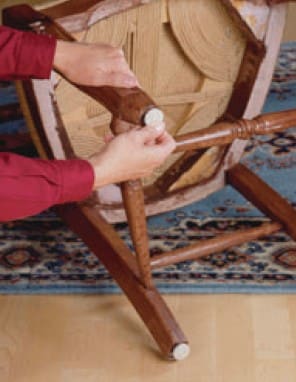
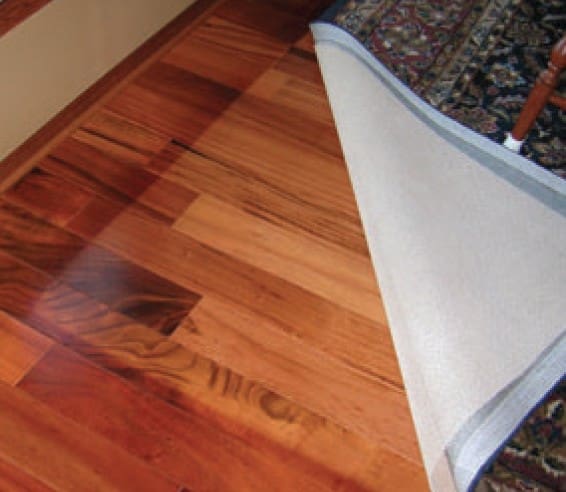
Apply felt to chair legs to protect the floor. Note colour variations where rugs have been covering a timber floor.

Oil-modified urethane
Timber floors are generally easy to maintain and greatly benefit from sensible use and regular care.
Ongoing Care and Maintenance
Ingress of Grit and Direct Sunlight
There are some things that are enemies to timber floor finishes and one of these is sand or grit that can be brought into the house with footwear. These small particles act like sandpaper resulting in scratches in the floor. Mats placed both outside and inside external doors provide a simple and effective means of significantly reducing grit from entering the house. Similarly, in high wear areas, carpet runners and rugs can be effective and can also add to the décor of the house. The kitchen floor generally experiences high wear and therefore a floor rug in this area can be particularly beneficial.
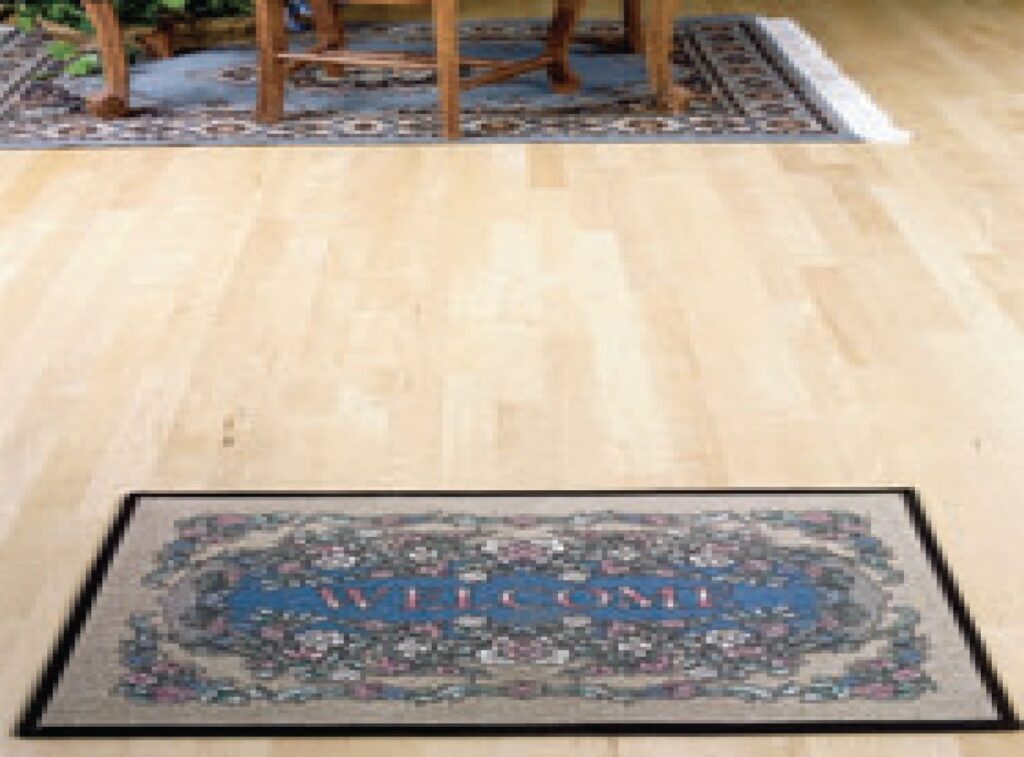
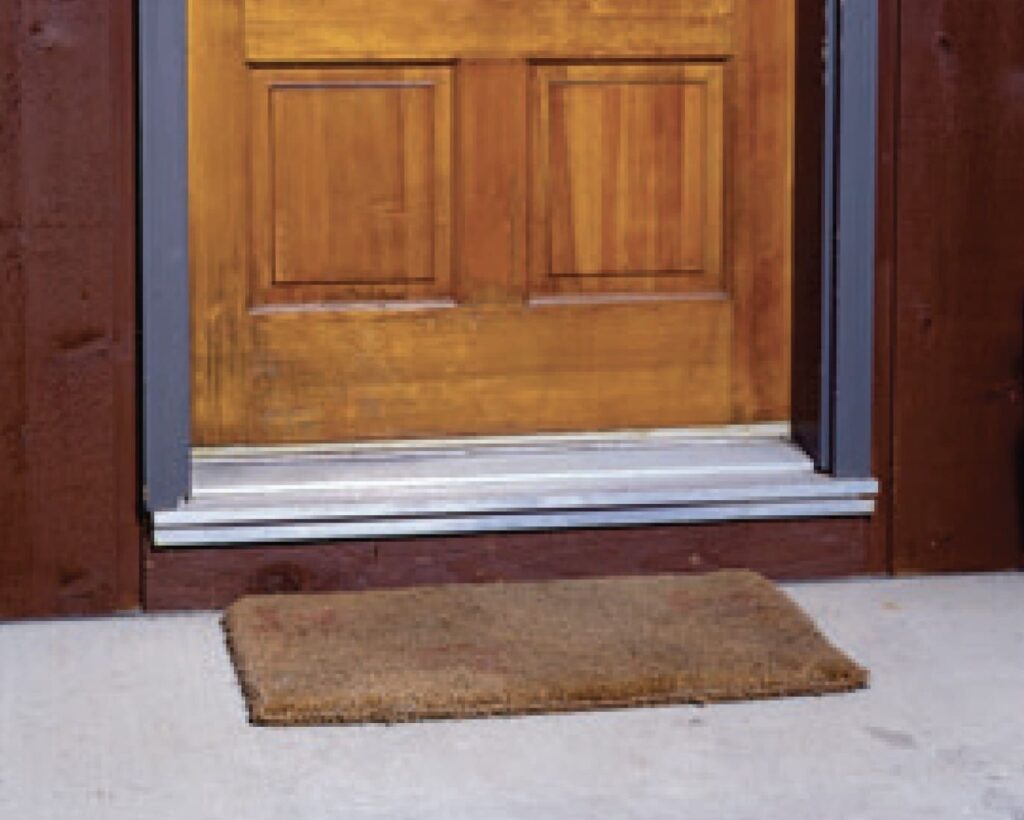
Adding rugs and mats at door entrances and under furniture will assist in protecting your flooring
Another aspect that should be considered is the amount of direct sunlight that is reaching the floor. Direct intense sunlight can contribute to gapping and possible cupping of boards (board edges higher than the centre of the board). It will also cause the colour of both boards and finish to change with time. Some floor finishes are more prone to darken with age and direct sunlight accelerates this process. Filtered sunlight through curtains or blinds provides an effective means of slowing the colour change processes and is also effective in controlling the gap width between and possible cupping of floor boards. In some instances it may be decided that window coverings will not be used, and if the sunlight has not been controlled by patio roofs or awnings then floors rugs can be used.
Steam mops
Everyone has seen the commercials showing steam cleaners magically sanitising, disinfecting, deodorising, and cleaning a timber floor. The manufacturers even advertise for use on timber floors, but that doesn’t mean that timber flooring manufacturers or finish manufacturers think steam mops are appropriate for a timber floor; in fact, some have begun to specifically mention steam mops in their list of ‘don’ts’. Steam mops can cause peeling of finish, whitening of the finish and a cloudy finish. Unless the timber flooring or finish manufacturer says it’s OK, it’s safest to assume steam cleaning is not appropriate on a timber floor

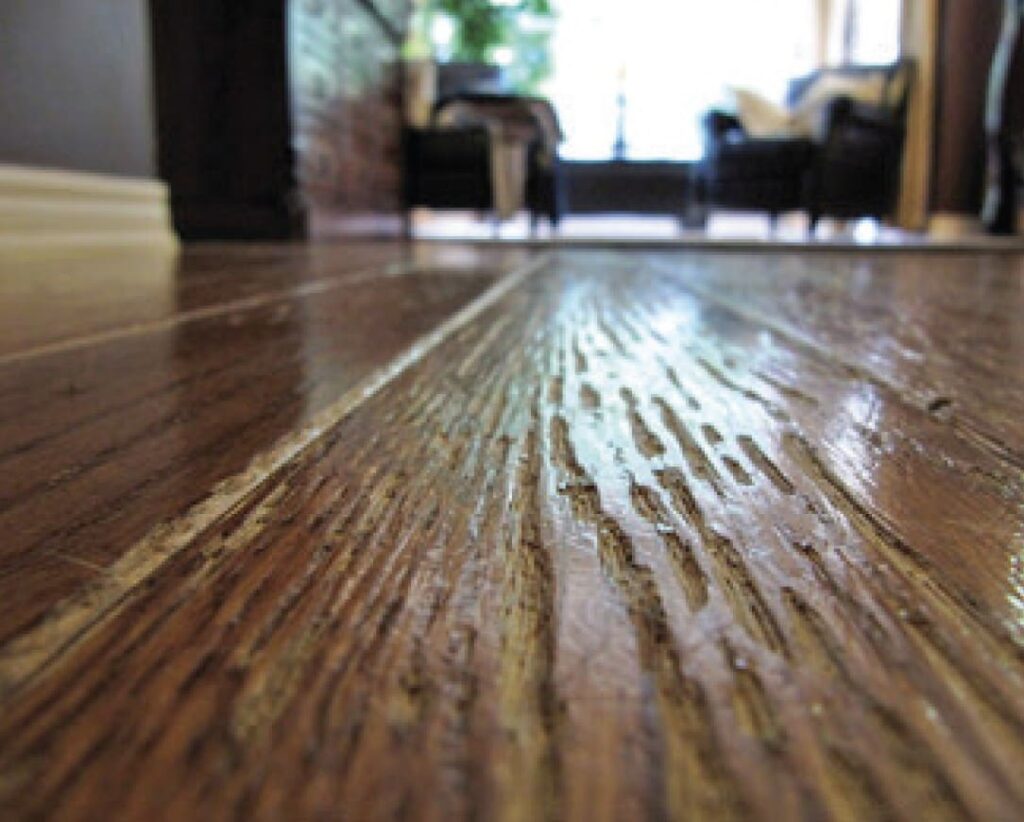
A prefinished timber floor damaged by repeated use of a steam mop cleaner
Maintenance Plan
Establishing a regular cleaning program will greatly assist in keeping floors in pristine condition. There are many aspects that affect how often the floor requires cleaning and these include the degree of grit present (particularly from children and pets), the types of exterior and interior matting used, the level of foot traffic, type of footwear and general conditions of the area outside the house. Spills should be mopped up when they occur and any leaks must be attended to immediately. Failure to attend to leaking pipe work can result in severe problems with a floor particularly when laid over sheet flooring or directly adhered to a concrete slab. Scuff marks or stubborn stains may be removed with light rubbing using a wood floor cleaner. As some cleaners can attack certain types of coating, where possible use the cleaning regime specified by the floor coating manufacturer – alternatively always test rub an isolated area of floor to verify compatibility of the cleaner with the coating.
General suggested cleaning products for coating types (though double check with the coating producer):
|
Coating or product type |
Cleaning process
|
|||
Brand specific cleaner that matches the coating |
Other cleaning methodologies | Steam mops |
Wet mopping |
|
|
1 and 2 pack solvent based polyurethanes |
yes |
Follow the advice provided by the coating manufacturer for your product. Note: use of domestic detergent, vinegar, methylated spirits or commercially available floor cleaners may damage your floor – consult the coating manufacturer of your product first. |
no |
No
|
|
1 and 2 pack water based polyurethanes |
yes |
no |
No
|
|
|
Hard wax oils |
yes |
no |
No
|
|
|
Penetrating oils |
yes |
no |
No
|
|
|
Oil modified urethanes |
yes |
no |
No
|
|
|
Pre-finished Engineered, Solid and Bamboo with UV cure |
yes |
no |
No
|
|
|
Laminate products |
yes |
no |
no
|
|
|
As coating properties can vary within a group it is always advisable to evaluate any cleaning products or techniques on a less conspicuous part of the floor surface prior to use.
|
||||
For regular cleaning of domestic floors an antistatic mop provides an effective means of collecting dust and grit. Continual walking on a dirty floor will quickly damage the finish. If a vacuum cleaner is used then the condition of the brushes should be regularly checked. If they have worn thin, contact of the metal head on the floor can result in scratching. Also, do not use hard head vacuum cleaners as they will invariably cause fine scratches on the floor.
On a fortnightly to monthly basis floors can also benefit from damp mopping. Providing the mop is only damp and the finish is in good condition, mopping carried out correctly will not affect either the finish or the timber.
Damp mopping provides an effective deep clean and should be undertaken with a neutral pH wood floor cleaner or product recommended by the finish manufacturer. Harsh detergents or abrasive cleaners are to be avoided. After wetting the mop it should be wrung out until it is moist before mopping. Using clean water, a final mopping with a mop wrung out till it is ‘dry’ may be used to further remove excess moisture on the boards. Periodically the protective pads on furniture legs should also be check to ensure that they are clean of grit or in need of replacement.
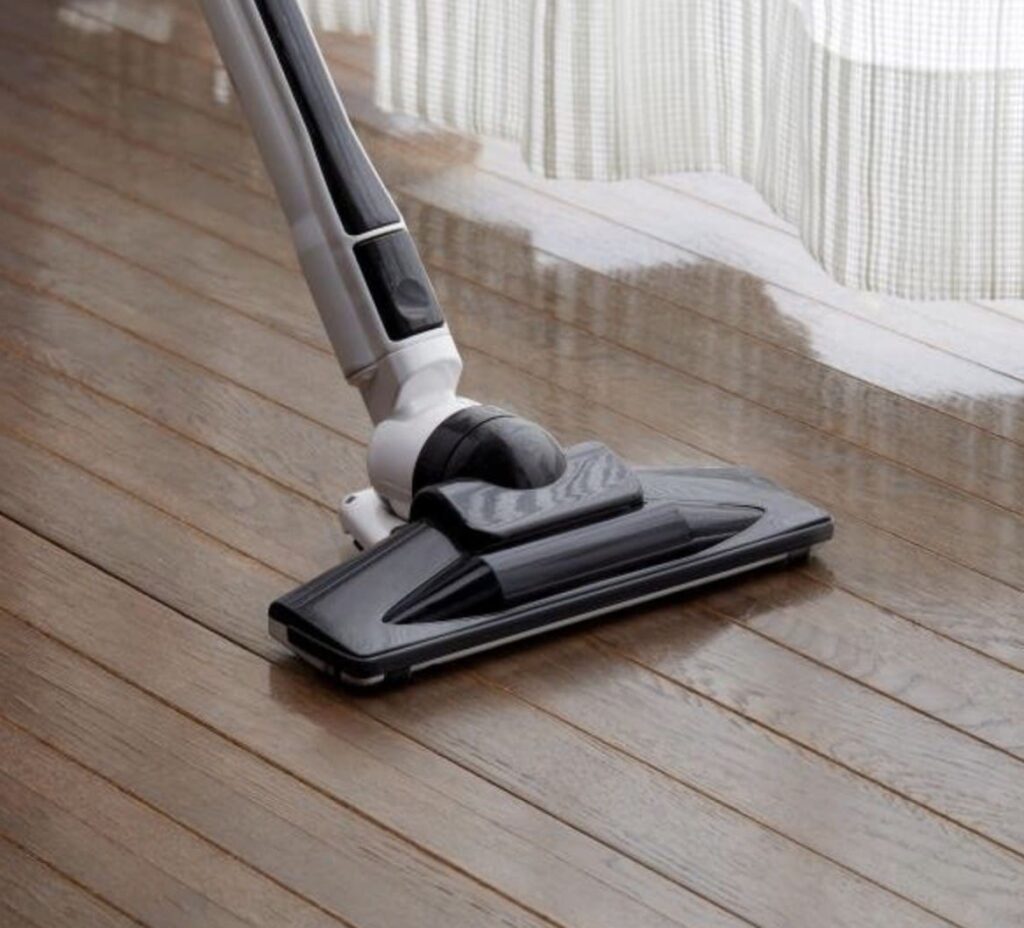
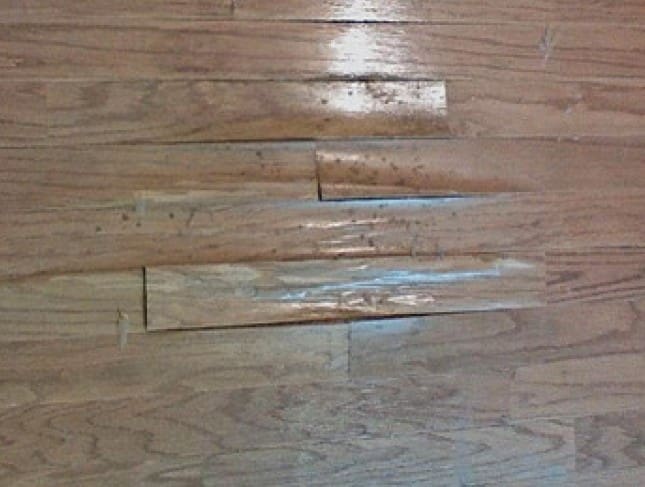
The photo above shows a floor that has been frequently wet mopped.
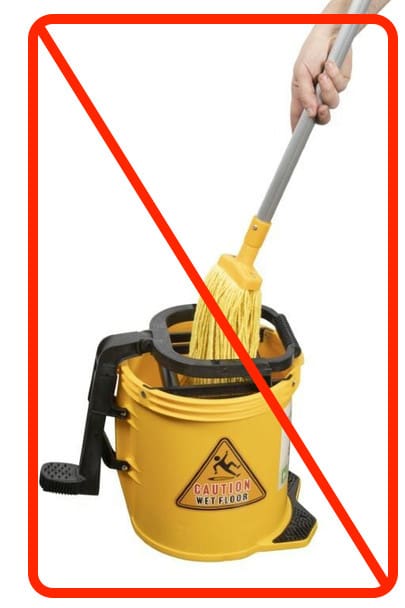
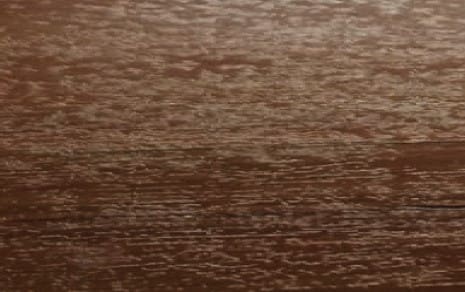
The above photo shows a 2 part water based floor coating after 3 weeks of cleaning with the wrong products.

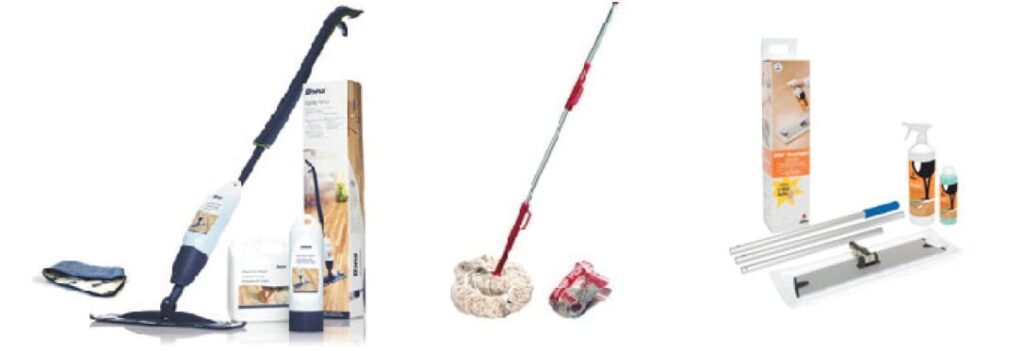
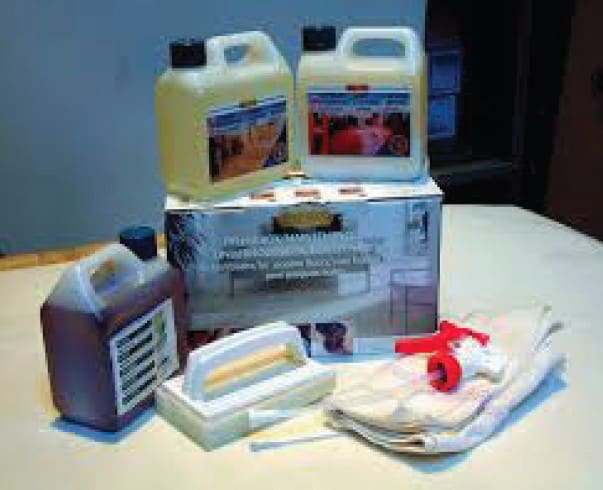
When is re-coating a floor necessary?
Timber floors are subject to different wear patterns and it is in areas of higher wear that there will initially be signs that the floor requires re-coating. It is important to ensure that excessive wear does not occur before re-coating the floor is considered. If wear has been excessive then a total re-sand and re-finish will be required.
The finish should be inspected in the high wear areas and if a few drops of water bead on the surface then the finish is still intact and may require cleaning rather than recoating. If however, after a few minutes the water begins to soak in and the timber colour darkens, then the finish is partially worn and recoating should be undertaken. It is important that the details of the original coating system can be made available to the sander and finisher to ensure compatibility between coats.

The photo above shows a floor that has worn through and requires a re-sanding.
Maintenance Mantras
These guidelines apply to any Timber floor. Following them will help your floor look good for longer between recoating and re-sanding:
- Anti-static mop, sweep and/or vacuum (soft head) the floor as often as possible.
- Never, ever wet-mop a floor.
- Only use cleaners that are recommended by timber floor coating manufacturers or timber floor manufacturers.
- DON’T use: ammonia-based cleaners, wax-based products (unless coating is oil or wax), detergents, bleach, polishes, abrasive cleaning soaps, steel wool or abrasive cloths, turps or kerosene.
- Use walk off, walk on mats and area rugs at all doorways (keep door mats clean).
- Put floor protectors on the bottom of all furniture and anything else that is hard and will make contact and might rub on the timber floor. (Lift and do not slide chairs.)
- Wipe up all spills immediately. Many beverages will stain most finishes if left on the floor.
- Keep pet nails trimmed. Know that dogs running through the house will scratch any finish.
- Consider using carpet runners/area rugs in high-traffic areas.
- Keep your home at normal living conditions for your area—no extremes of humidity or temperature.
- Protect your floor from direct sunlight. Prolonged exposure to sunlight can soften the tone of different species of timber to varying degrees and accelerate the darkening from oxidation and aging of timber and the coating.
- DON’T wear shoes with stiletto heels on your timber floor. Remove shoes at the door to avoid potentially dragging in sharp objects in your shoe treads.
- Rearrange your rugs and furniture periodically to allow the flooring colour to age evenly.
